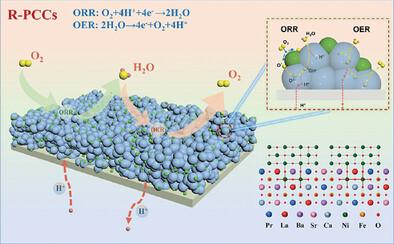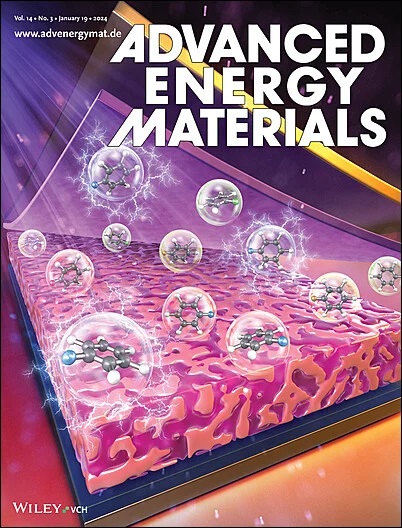High-Entropy Driven Self-Assembled Dual-phase Composite Air Electrodes with Enhanced Performance and Stability for Reversible Protonic Ceramic Cells
IF 24.4
1区 材料科学
Q1 CHEMISTRY, PHYSICAL
引用次数: 0
Abstract
Reversible proton ceramic cells (R-PCCs) offer a transformative solution for dual functionality in power generation and energy storage. However, their potential is currently obstacles by the lack of high-performance air electrodes combining high electrocatalytic activity with durability. Here, an innovative air electrode composed of high-entropy driven self-assembled xNiO-Pr0.2La0.2Ba0.2Sr0.2Ca0.2Fe0.8Ni0.2−xO3−δ (N-XFN) composites is presented, which result from the unique lattice distortion effects inherent in high-entropy perovskites. The experimental results coupled with density functional theory (DFT) calculations verify that the lattice distortion at the high-entropy A-site significantly induces NiO nanoparticles exsolved from the B-site, promoting the formation of a biphasic composite structure that dramatically increases the electrochemical active sites. Remarkably, R-PCCs using the N-XFN composite air electrode achieve an impressive peak power density of 1.30 W cm−2 in fuel cell mode and a current density of -2.52 A cm−2 at 1.3 V in electrolysis mode at 650 °C. In addition, the cells show excellent stability with reversibility over 830 h, including 500 h in electrolysis mode and 330 h in reversible operation at 650 °C. This research provides important insights into the design of high-entropy perovskites, paving the way for advanced R-PCCs technology.

求助全文
约1分钟内获得全文
求助全文
来源期刊

Advanced Energy Materials
CHEMISTRY, PHYSICAL-ENERGY & FUELS
CiteScore
41.90
自引率
4.00%
发文量
889
审稿时长
1.4 months
期刊介绍:
Established in 2011, Advanced Energy Materials is an international, interdisciplinary, English-language journal that focuses on materials used in energy harvesting, conversion, and storage. It is regarded as a top-quality journal alongside Advanced Materials, Advanced Functional Materials, and Small.
With a 2022 Impact Factor of 27.8, Advanced Energy Materials is considered a prime source for the best energy-related research. The journal covers a wide range of topics in energy-related research, including organic and inorganic photovoltaics, batteries and supercapacitors, fuel cells, hydrogen generation and storage, thermoelectrics, water splitting and photocatalysis, solar fuels and thermosolar power, magnetocalorics, and piezoelectronics.
The readership of Advanced Energy Materials includes materials scientists, chemists, physicists, and engineers in both academia and industry. The journal is indexed in various databases and collections, such as Advanced Technologies & Aerospace Database, FIZ Karlsruhe, INSPEC (IET), Science Citation Index Expanded, Technology Collection, and Web of Science, among others.
 求助内容:
求助内容: 应助结果提醒方式:
应助结果提醒方式:


